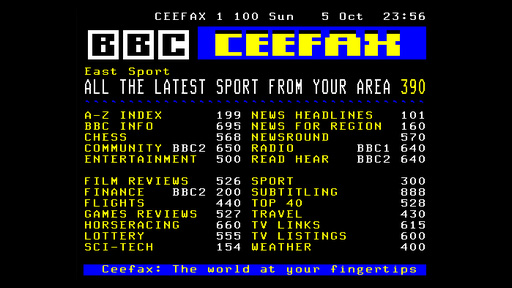It is 50 years since the BBC launched CEEFAX, the first Teletext service, indeed the first digital television service, which in some ways heralded the start of interactive television. It is also exactly 25 years since the launch of its successor, BBC Text.
To commemorate 50 years of Teletext services, the Centre for Computing History in Cambridge held a weekend for enthusiasts to celebrate the medium, including an online festival of teletext art. There is also a documentary, Teletext@50 available on YouTube and a podcast audio version.

BBC Ceefax went live on 23 September 1974. The service, which allowed users to check the latest headlines and sports results at the touch of a few buttons on a television remote control, was revolutionary at the time. It was the first implementation of broadcast Teletext, which went on to become used around the world as World System Teletext.
The broadcast technology was originally developed by Philips as a way to deliver digital text for subtitles for deaf and hearing-impaired viewers, packed into spare lines of the vertical blanking interval at the top of a 625-line analogue television signal.
The BBC realised that this could be used to deliver other types of information, including news headlines, sports results, and programme information.
ITV later offered a similar system it called ORACLE, which stood for Optional Reception of Announcements by Coded Line Electronics, which was transmitted from 1978.
The teletext system displayed text in seven different colours, with 24 lines of up to 40 characters per page, including basic graphics characters, with special codes for double-height characters. The pages were transmitted sequentially, in a carousel, with popular pages transmitted more frequently than others.
Pages could be accessed by selecting teletext, typing in a three-digit number on their television remote control, and waiting for the page to appear on screen.
By the 1990s, most televisions sold in Europe offered support for teletext and the services were used by millions of users a week.
With the advent of digital television, more advanced interactive information services could be delivered.
The BBC Text service launched on digital terrestrial television on 23 September 1999, although it had been available in test for almost a year and was subsequently introduced on cable and satellite platforms.
The CEEFAX service was closed on 23 October 2012 with the end of analogue transmissions.
The BBC Text service was due to close in 2020 but was given a reprieve following representations from users about the removal of the service.
